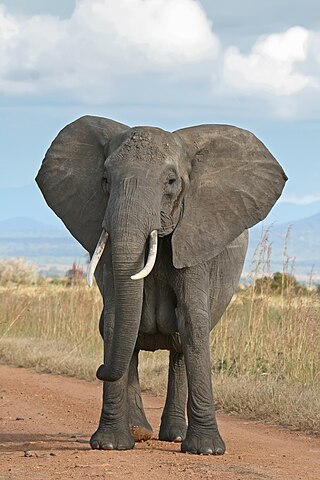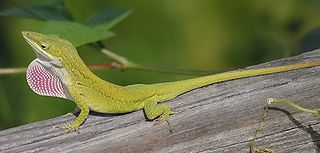
In evolutionary biology, adaptive radiation is a process in which organisms diversify rapidly from an ancestral species into a multitude of new forms, particularly when a change in the environment makes new resources available, alters biotic interactions or opens new environmental niches. Starting with a single ancestor, this process results in the speciation and phenotypic adaptation of an array of species exhibiting different morphological and physiological traits. The prototypical example of adaptive radiation is finch speciation on the Galapagos, but examples are known from around the world.

Elephants are the largest living land animals. Three living species are currently recognised: the African bush elephant, the African forest elephant, and the Asian elephant. They are the only surviving members of the family Elephantidae and the order Proboscidea; extinct relatives include mammoths and mastodons. Distinctive features of elephants include a long proboscis called a trunk, tusks, large ear flaps, pillar-like legs, and tough but sensitive grey skin. The trunk is prehensile, bringing food and water to the mouth and grasping objects. Tusks, which are derived from the incisor teeth, serve both as weapons and as tools for moving objects and digging. The large ear flaps assist in maintaining a constant body temperature as well as in communication. African elephants have larger ears and concave backs, whereas Asian elephants have smaller ears and convex or level backs.

The Proboscidea are a taxonomic order of afrotherian mammals containing one living family (Elephantidae) and several extinct families. First described by J. Illiger in 1811, it encompasses the elephants and their close relatives. From the mid-Miocene onwards, most proboscideans were very large. The largest land mammal of all time may have been a proboscidean; Palaeoloxodon namadicus was up to 5.2 m (17.1 ft) at the shoulder and may have weighed up to 22 t, almost double the weight of some sauropods like Diplodocus carnegii. The largest extant proboscidean is the African bush elephant, with a record of size of 4 m (13.1 ft) at the shoulder and 10.4 t. In addition to their enormous size, later proboscideans are distinguished by tusks and long, muscular trunks, which were less developed or absent in early proboscideans.

Dactyloidae are a family of lizards commonly known as anoles and native to warmer parts of the Americas, ranging from southeastern United States to Paraguay. Instead of treating it as a family, some authorities prefer to treat it as a subfamily, Dactyloidae, of the family Iguanidae. In the past they were included in the family Polychrotidae together with Polychrus, but the latter genus is not closely related to the true anoles.

The Iguanidae is a family of lizards composed of the iguanas, chuckwallas, and their prehistoric relatives, including the widespread green iguana.

Anolis is a genus of anoles, iguanian lizards in the family Dactyloidae, native to the Americas. With more than 425 species, it represents the world's most species-rich amniote tetrapod genus, although many of these have been proposed to be moved to other genera, in which case only about 45 Anolis species remain. Previously, it was classified under the family Polychrotidae that contained all the anoles, as well as Polychrus, but recent studies place it in the Dactyloidae.

Anolis carolinensis or green anole is a tree-dwelling species of anole lizard native to the southeastern United States and introduced to islands in the Pacific and Caribbean. A small to medium-sized lizard, the green anole is a trunk-crown ecomorph and can change its color to several shades from brown to green.

The brown anole, also known commonly as the Cuban brown anole, or De la Sagra's anole, is a species of lizard in the family Dactyloidae. The species is native to Cuba and the Bahamas. It has been widely introduced elsewhere, via the importation and exportation of plants where the anole would lay eggs in the soil of the pots, and is now found in Florida and as far north in the United States as southern Georgia, Texas, Louisiana, Tennessee, Mississippi, Alabama, Hawaii, and Southern California. It has also been introduced to other Caribbean islands, Mexico, and Taiwan.

Anolis pulchellus, the Puerto Rican anole, Puerto Rican bush anole, snake anole, or sharp-mouthed lizard, is a small species of anole lizard in the family Dactyloidae. The species is among the most common lizards in Puerto Rico, and also native to Vieques, Culebra, and the Virgin Islands.

The African bush elephant, also known as the African savanna elephant, is one of two extant African elephant species and one of three extant elephant species. It is the largest living terrestrial animal, with bulls reaching a shoulder height of up to 3.96 m and a body mass of up to 10.4 t.
Genetic admixture occurs when previously diverged or isolated genetic lineages mix. Admixture results in the introduction of new genetic lineages into a population.
The Daniel Giraud Elliot Medal is awarded by the U.S. National Academy of Sciences "for meritorious work in zoology or paleontology study published in a three- to five-year period." Named after Daniel Giraud Elliot, it was first awarded in 1917.
Duncan Irschick is an evolutionary ecologist and functional morphologist in the field of animal athletics, more specifically known as animal performance. He has worked on many kinds of animal species, including reptiles and amphibians, rodents, ungulates, spiders, and humans. He was a faculty member at Tulane University for five years (2001–2006) before joining the faculty at the University of Massachusetts at Amherst in 2006.

The ecomorph concept is a term first coined by Ernest Edward Williams in 1972 which he defined as a “species with the same structural habitat/niche, similar in morphology and behavior, but not necessarily close phyletically.” Williams first applied this definition to the Greater Antillean anoles upon observing their evolutionary radiation, although it has since been used widely elsewhere.
Kevin de Queiroz is a vertebrate, evolutionary, and systematic biologist. He has worked in the phylogenetics and evolutionary biology of squamate reptiles, the development of a unified species concept and of a phylogenetic approach to biological nomenclature, and the philosophy of systematic biology.
Jonathan B. Losos is an American evolutionary biologist and Herpetologist.
Tomislav Domazet-Lošo is a Croatian geneticist. His fields of interest are evolutionary genetics, evolutionary developmental biology, macroevolution, and tumor evolution. He is currently employed at the Ruđer Bošković Institute as a researcher.

Meghan Anne Duffy is an American biologist and the Susan S. Kilham Collegiate Professor of Ecology and Evolutionary Biology at the University of Michigan. She focuses on the causes and consequences of parasitism in natural populations of lake populations. In 2019, she created a task force to examine factors that influence the mental health and well-being of graduate students at the University of Michigan.
Victoria Louise Sork is an American scientist who is Professor and Dean of Life Sciences at University of California, Los Angeles. She studies tree populations in California and the Eastern United States using genomics, evolutionary biology and conservation biology. Sork is a Fellow of the American Association for the Advancement of Science.
John R. Stinchcombe is a American and Canadian ecological geneticist who is a professor of ecology and evolutionary biology at the University of Toronto. His research is on the ecology of natural selection, and the role of genetics in facilitating or constraining evolution, focusing almost exclusively on plants.











